Wind Tunnel Investigation of the Icing of a Drone Rotor in Forward Flight
Abstract
1. Introduction
2. Materials and Methods
2.1. Icing Wind Tunnel
2.2. UAV Drone Rotor Setup
2.3. Test Parameters
2.4. Post-Processing and Non-Dimensional Coefficients
3. Results
3.1. Liquid Water Content
3.2. Droplet Size (MVD)
3.3. Rotor Speed
3.4. Pitch Angle
4. Conclusions
Author Contributions
Funding
Data Availability Statement
Conflicts of Interest
References
- Transport Canada. Transport Canada’s Drone Strategy to 2025; Transport Canada: Ottawa, ON, Canada, 2021.
- Villeneuve, E.; Karmouch, E.; Boulerice, X. Development of a small and transportable de-icing/anti-icing drone-mounted system. Part 1: System design. Drone Syst. Appl. 2022, 2, 28. [Google Scholar] [CrossRef]
- Hann, R.; Johansen, T.A. Unsettled Topics in Unmanned Aerial Vehicle Icing; SAE Technical Paper; SAE International: Warrendale, PA, USA, 2020. [Google Scholar]
- Federal Aviation Administration. UAS by the Numbers. 2021. Available online: https://www.faa.gov/node/54496 (accessed on 23 November 2021).
- Adamski, M. Analysis of propulsion systems of unmanned aerial vehicles. J. Mar. Eng. Technol. 2017, 16, 291–297. [Google Scholar] [CrossRef]
- Cao, Y.; Tan, W.; Wu, Z. Aircraft icing: An ongoing threat to aviation safety. Aerosp. Sci. Technol. 2018, 75, 353–385. [Google Scholar] [CrossRef]
- Potapczuk, M.G. Aircraft icing research at NASA Glenn research center. J. Aerosp. Eng. 2013, 26, 260–276. [Google Scholar] [CrossRef]
- Dukhan, N.; De Witt, K.J.; Masiulaniec, K.; Van Fossen, G.J., Jr. Experimental Frossling numbers for ice-roughened NACA 0012 airfoils. J. Aircr. 2003, 40, 1161–1167. [Google Scholar] [CrossRef]
- Fortin, G.; Laforte, J.-L.; Beisswenger, A. Prediction of ice shapes on NACA0012 2D airfoil. In Proceedings of the FAA In-Flight Icing/Ground De-Icing International Conference & Exhibition, Chicago, IL, USA, 16–20 June 2003; SAE International: Warrendale, PA, USA, 2003. [Google Scholar]
- Özgen, S.; Canıbek, M. Ice accretion simulation on multi-element airfoils using extended Messinger model. J. Heat Mass Transf. 2009, 45, 305–322. [Google Scholar] [CrossRef]
- Tsao, J.-C.; Lee, S. Evaluation of Icing Scaling on Swept NACA 0012 Airfoil Models; NASA Glenn Research Center: Cleveland, OH, USA, 2012.
- Tsao, J.-C. Further Evaluation of Swept Wing Icing Scaling with Maximum Combined Cross Section Ice Shape Profiles. In Proceedings of the 2018 Atmospheric and Space Environments Conference, Atlanta, GA, USA, 25–29 June 2018; American Institute of Aeronautics and Astronautics: Atlanta, GA, USA, 2018; p. 3183. [Google Scholar]
- Liu, Y.; Zhang, K.; Tian, W.; Hu, H. An experimental investigation on the dynamic ice accretion and unsteady heat transfer over an airfoil surface with embedded initial ice roughness. Int. J. Heat Mass Transf. 2020, 146, 118900. [Google Scholar] [CrossRef]
- Tsao, J.-C.; Kreeger, R. Further Evaluation of Scaling Methods for Rotorcraft Icing; 0148-7191; SAE Technical Paper; SAE International: Warrendale, PA, USA, 2011. [Google Scholar]
- Palacios, J.L.; Han, Y.; Brouwers, E.W.; Smith, E.C. Icing environment rotor test stand liquid water content measurement procedures and ice shape correlation. J. Am. Helicopter Soc. 2012, 57, 29–40. [Google Scholar] [CrossRef]
- Wright, J.; Aubert, R. Icing wind tunnel test of a full scale heated tail rotor model. In Proceedings of the AHS 70th Annual Forum, Montreal, QC, Canada, 20–22 May 2014; American Helicopter Society (AHS): Montreal, QC, Canada; pp. 20–22. [Google Scholar]
- Li, Y.; Sun, C.; Jiang, Y.; Feng, F. Scaling method of the rotating blade of a wind turbine for a rime ice wind tunnel test. Energies 2019, 12, 627. [Google Scholar] [CrossRef]
- Wang, Z.; Zhu, C.; Zhao, N. Experimental Study on the Effect of Different Parameters on Rotor Blade Icing in a Cold Chamber. Appl. Sci. 2020, 10, 5884. [Google Scholar] [CrossRef]
- Fortin, G.; Perron, J. Spinning rotor blade tests in icing wind tunnel. In Proceedings of the 1st AIAA Atmospheric and Space Environments Conference, San Antonio, TX, USA, 22–25 June 2009; American Institute Aeronautics and Astronautics: San Antonio, TX, USA, 2009; p. 4260. [Google Scholar]
- Narducci, R.; Kreeger, R.E. Analysis of a Hovering Rotor in Icing Conditions; NASA: Phoenix, AZ, USA, 2012.
- Narducci, R.; Kreeger, R.E. Application of a High-Fidelity Icing Analysis Method to a Model-Scale Rotor in Forward Flight; NASA: Virginia Beach, VA, USA, 2012.
- Chen, L.; Zhang, Y.; Wu, Q.; Chen, Z.; Peng, Y. Numerical simulation and optimization analysis of anti-/de-icing component of helicopter rotor based on big data analytics. In Communications in Computer and Information Science; Springer: Singapore, 2016; pp. 585–601. [Google Scholar]
- Liu, Y.; Li, L.; Li, H.; Hu, H. An experimental study of surface wettability effects on dynamic ice accretion process over an UAS propeller model. Aerosp. Sci. Technol. 2018, 73, 164–172. [Google Scholar] [CrossRef]
- Liu, Y.; Li, L.; Ning, Z.; Tian, W.; Hu, H. Experimental investigation on the dynamic icing process over a rotating propeller model. J. Propuls. Power 2018, 34, 933–946. [Google Scholar] [CrossRef]
- Müller, N.; Hann, R.; Lutz, T. UAV Icing: Numerical Simulation of Propeller Ice Accretion. In Proceedings of the AIAA Aviation 2021 Forum, Virtual Event, 2–6 August 2021; p. 2673. [Google Scholar]
- Siquig, R. Impact of Icing on Unmanned Aerial Vehicle (UAV) Operations; Naval Environmental Prediction Research Facility: Monterey, CA, USA, 1990. [Google Scholar]
- Yamazaki, M.; Jemcov, A.; Sakaue, H. A Review on the Current Status of Icing Physics and Mitigation in Aviation. J. Aerosp. 2021, 8, 188. [Google Scholar] [CrossRef]
- Bottyán, Z. In-flight icing characteristics of unmanned aerial vehicles during special atmospheric condition over the carpathian-basin. Acta Geogr. Debrecina Landsc. Environ. Ser. 2014, 7, 74–80. [Google Scholar]
- Szilder, K.; McIlwain, S. In-flight icing of UAVs–the influence of flight speed coupled with chord size. Can. Aeronaut. Space J. 2012, 58, 83–94. [Google Scholar] [CrossRef]
- Armanini, S.; Polak, M.; Gautrey, J.E.; Lucas, A.; Whidborne, J.F. Decision-making for unmanned aerial vehicle operation in icing conditions. CEAS Aeronaut. J. 2016, 7, 663–675. [Google Scholar] [CrossRef]
- Løw-Hansen, B.; Hann, R.; Stovner, B.N.; Johansen, T.A. UAV Icing: A Survey of Recent Developments in Ice Detection Methods. IFAC-Pap. 2023, 56, 10727–10739. [Google Scholar] [CrossRef]
- Enache, A.; Wallisch, J.; van Beeck, J.; Hendrick, P.; Hann, R. Ice Accretion: Image Post-Processing Measurement Techniques for 2D Ice Shapes. Aerospace 2023, 10, 451. [Google Scholar] [CrossRef]
- Hann, R.; Engineer, L.A. Requirements for Uav Operations in Cold Climates and Icing Conditions. 2024. Available online: https://www.ubiqaerospace.com/uav-requirements (accessed on 23 November 2021).
- Müller, N.C.; Løw-Hansen, B.; Borup, K.T.; Hann, R. UAV icing: Development of an ice protection system for the propeller of a small UAV. Cold Reg. Sci. Technol. 2023, 213, 103938. [Google Scholar] [CrossRef]
- Frey, M.; Müller, N.C.; Wallisch, J.; Hann, R. UAV Icing: Experimental Investigation and Numerical CHT Simulations of a Propeller Ice Protection System. In AIAA SCITECH 2024 Forum; American Institute of Aeronautics and Astronautics: Atlanta, GA, USA, 2024. [Google Scholar]
- Hann, R. Numerical Simulation of In-Flight Icing of Unmanned Aerial Vehicles. In Handbook of Numerical Simulation of In-Flight Icing; Habashi, W.G., Ed.; Springer International Publishing: Cham, Switzerland, 2020; pp. 1–44. [Google Scholar]
- Villeneuve, E.; Samad, A.; Volat, C.; Béland, M.; Lapalme, M. An Experimental Apparatus for Icing Tests of Low Altitude Hovering Drones. Drones 2022, 6, 19. [Google Scholar] [CrossRef]
- Villeneuve, E.; Samad, A.; Volat, C.; Béland, M.; Lapalme, M. Experimental Investigation of Icing Effects on a Hovering Drone Rotor Performance. Drones 2022, 6, 345. [Google Scholar] [CrossRef]
- Samad, A.; Villeneuve, E.; Volat, C.; Béland, M.; Lapalme, M. Experimental assessment of the ice protection effectiveness of electrothermal heating for a hovering drone rotor. Exp. Therm. Fluid Sci. 2023, 149, 110992. [Google Scholar] [CrossRef]
- Villeneuve, É.; Samad, A.; Volat, C.; Béland, M.; Lapalme, M. Experimental assessment of the ice protection effectiveness of icephobic coatings for a hovering drone rotor. Cold Reg. Sci. Technol. 2023, 210, 103858. [Google Scholar] [CrossRef]
- Harvey, D.; Villeneuve, E.; Volat, C.; Beland, M.; Lapalme, M. Experimental Evaluation of Icephobic Coatings on a UAV Propeller Operated in an Icing Wind Tunnel; SAE Technical Paper 2023-01-1443; SAE International: Warrendale, PA, USA, 2023. [Google Scholar]
- SAE International. Calibration and Acceptance of Icing Wind Tunnels; SAE International: Warrendale, PA, USA, 2003. [Google Scholar]
- SAE International. Droplet Size Instrumentation Used in Icing Facilities; SAE International: Warrendale, PA, USA, 1995. [Google Scholar]
- FAA. AC 29-2C Certification ofTransport Category Rotorcraft Transportation; United States Department of Transportation, Ed.; FAA: Washington, DC, USA, 2023; p. 1453.
- Jewel, B.; Barlow, W.H.R.; Pope, A. Low-Speed Wind Tunnel Testing, 3rd ed.; Wiley: Hoboken, NJ, USA, 1999; p. 736. [Google Scholar]
- Samad, A.; Villeneuve, E.; Blackburn, C.; Morency, F.; Volat, C. An experimental investigation of the convective heat transfer on a small helicopter rotor with anti-icing and de-icing test setups. Aerospace 2021, 8, 96. [Google Scholar] [CrossRef]
- Anttho, A.M.; Slupski, B.J.; Mohiudeen, A.; Kara, K. Determination of Water Droplet Collection Efficiency: An Empirical Model. In Proceedings of the AIAA Atmospheric Flight Mechanics Conference, Denver, CO, USA, 5–9 June 2017. [Google Scholar]
- Orchard, D. Investigation of Tolerance for Icing of UAV Rotors/Propellers: Phase 3 Test Results; No. LM-AL-2021-0051; Laboratory Memorandum (National Research Council of Ottawa, Canada. Aerospace. Aerodynamics Laboratory): Ottawa, ON, USA, 2021. [Google Scholar]
- Samad, A.; Villeneuve, E.; Morency, F.; Volat, C. A numerical and experimental investigation of the convective heat transfer on a small helicopter rotor test setup. Aerospace 2021, 8, 53. [Google Scholar] [CrossRef]
- Hansman Jr, R.J.; Yamaguchi, K.; Berkowitz, B.; Potapczuk, M. Modeling of surface roughness effects on glaze ice accretion. J. Thermophys. Heat Transf. 1991, 5, 54–60. [Google Scholar] [CrossRef]
- Chen, X.; Zhao, Q.-J. Numerical simulations for ice accretion on rotors using new three-dimensional icing model. J. Aircr. 2017, 54, 1428–1442. [Google Scholar]
- Lee, J.D.; Harding, R.; Palko, R.L. Documentation of Ice Shapes on the Main Rotor of a UH-1H Helicopter in Hover; Ohio State University: Columbus, OH, USA, 1984. [Google Scholar]
- Brouwers, E.W.; Palacios, J.L.; Smith, E.C.; Peterson, A.A. The experimental Investigation of A Rotor Hover Icing Model with Shedding. In Proceedings of the American Helicopter Society 66th Annual Forum, Phoenix, AZ, USA, 11–13 May 2010. [Google Scholar]

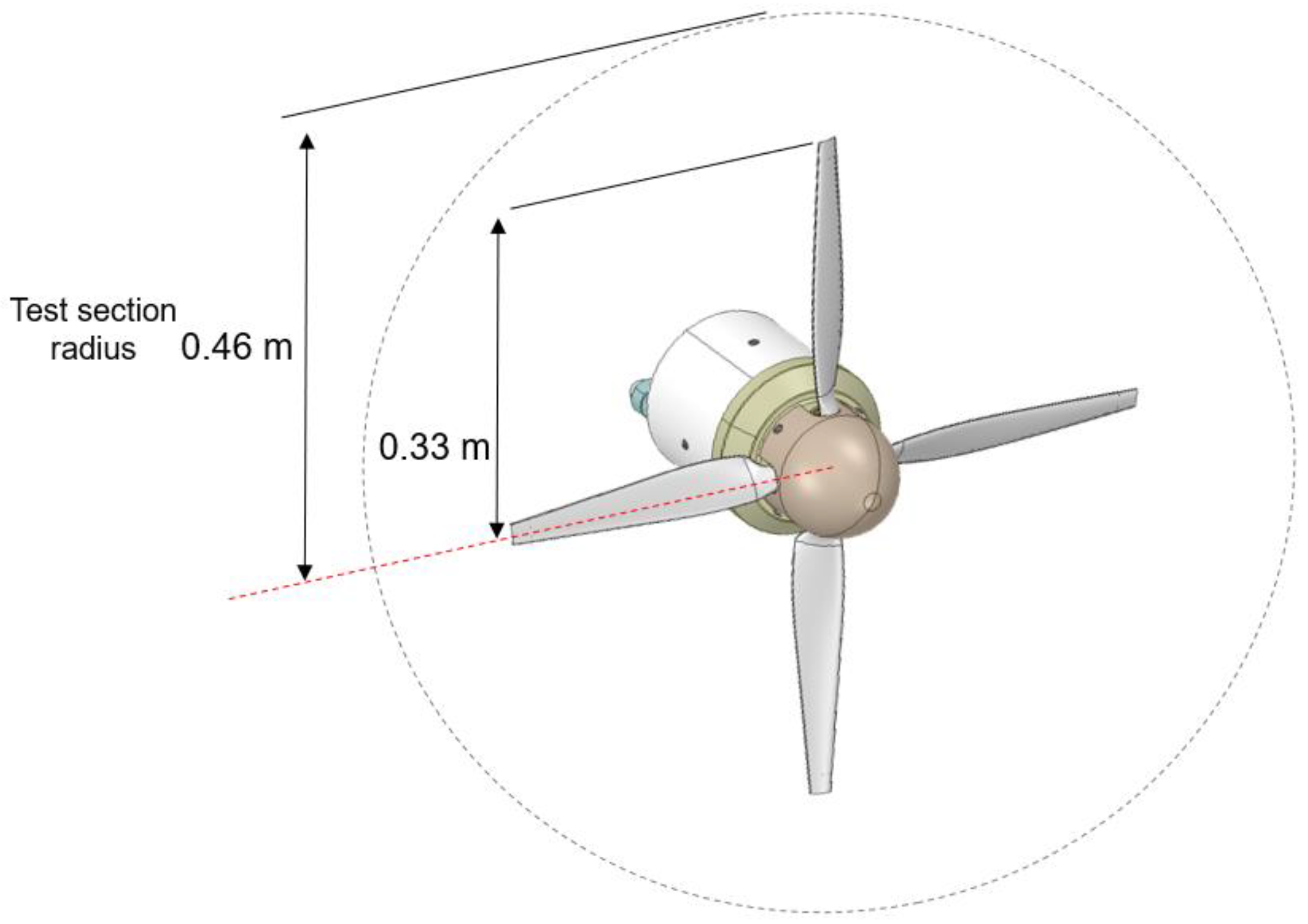



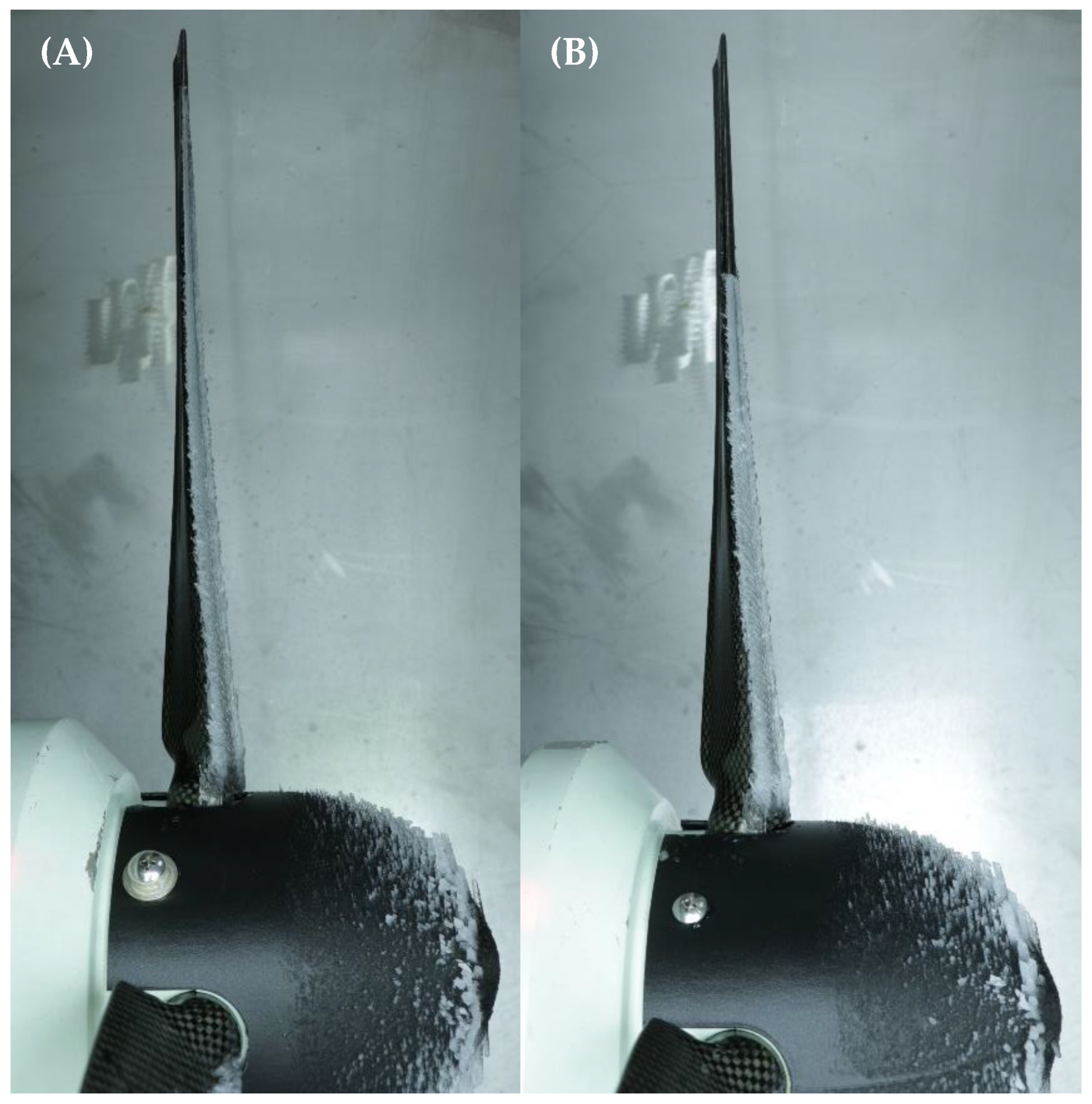

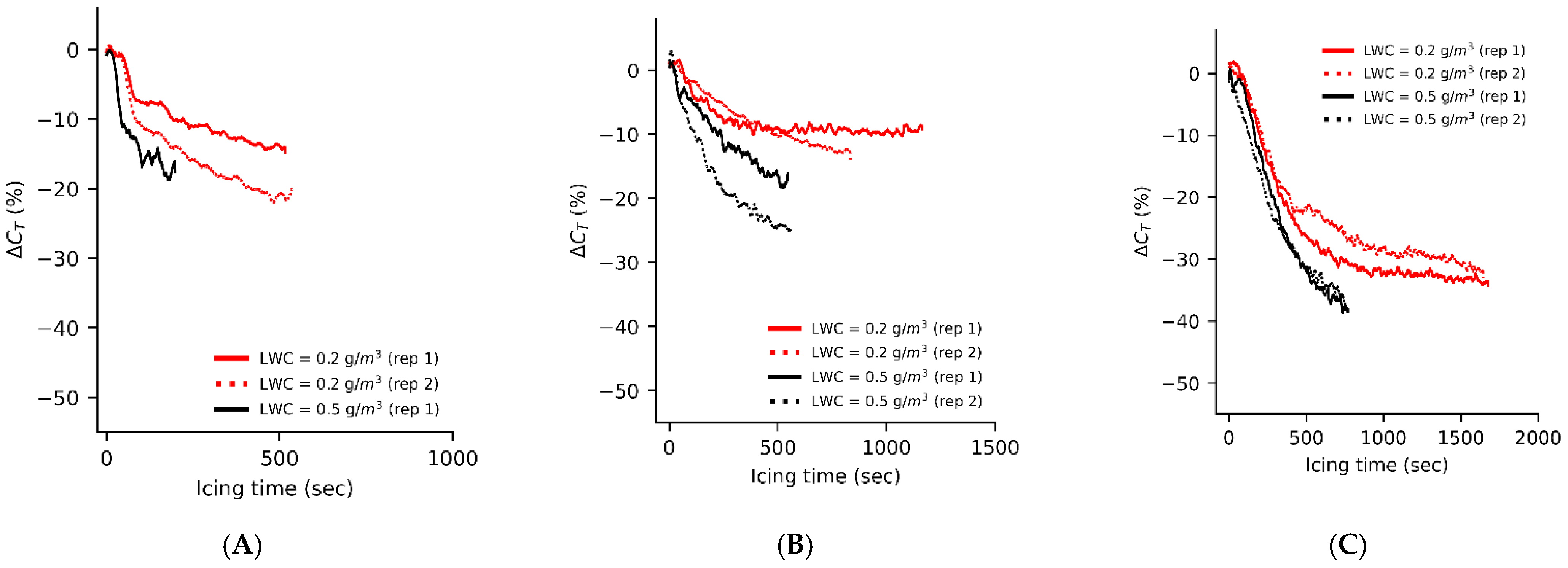

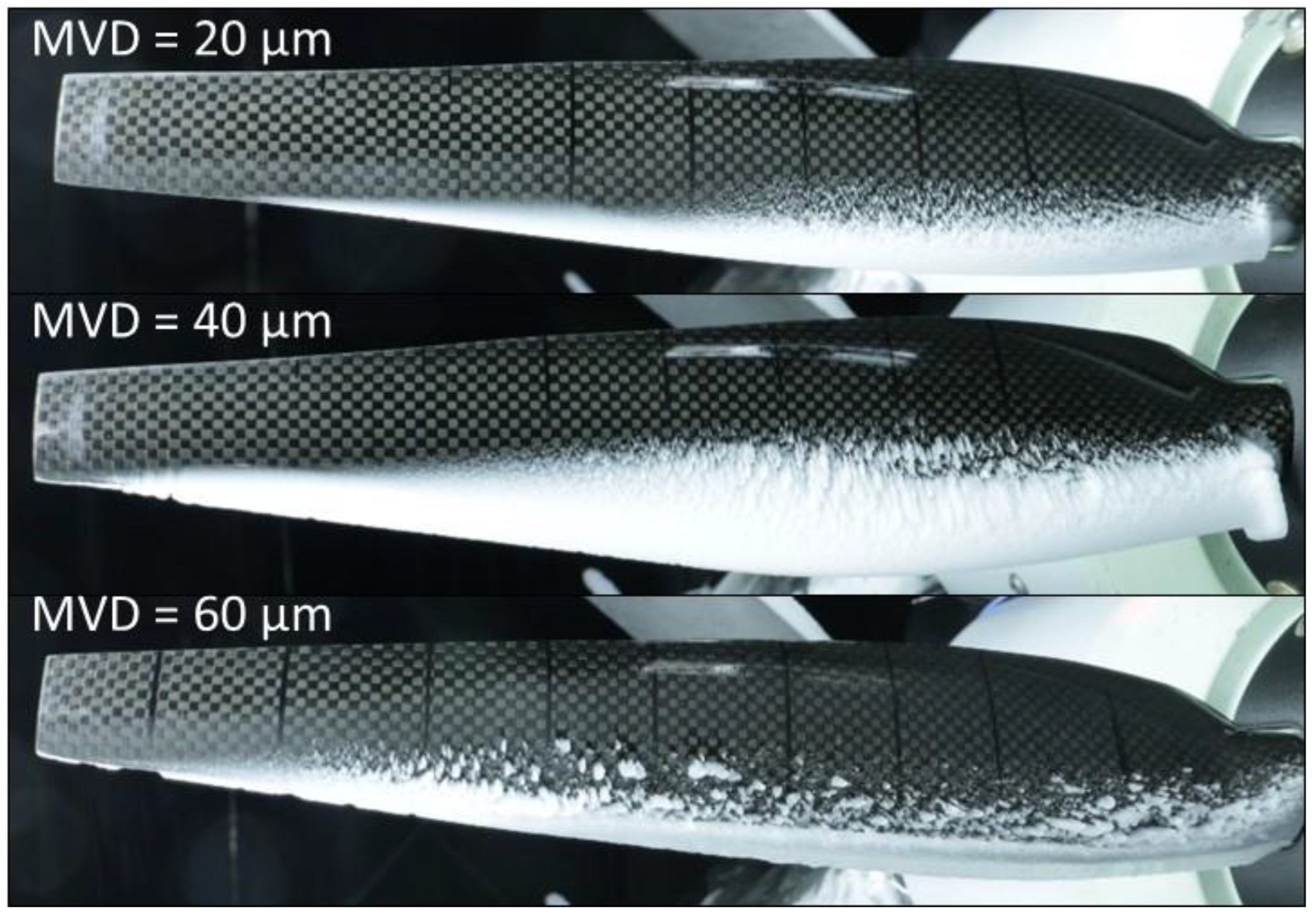

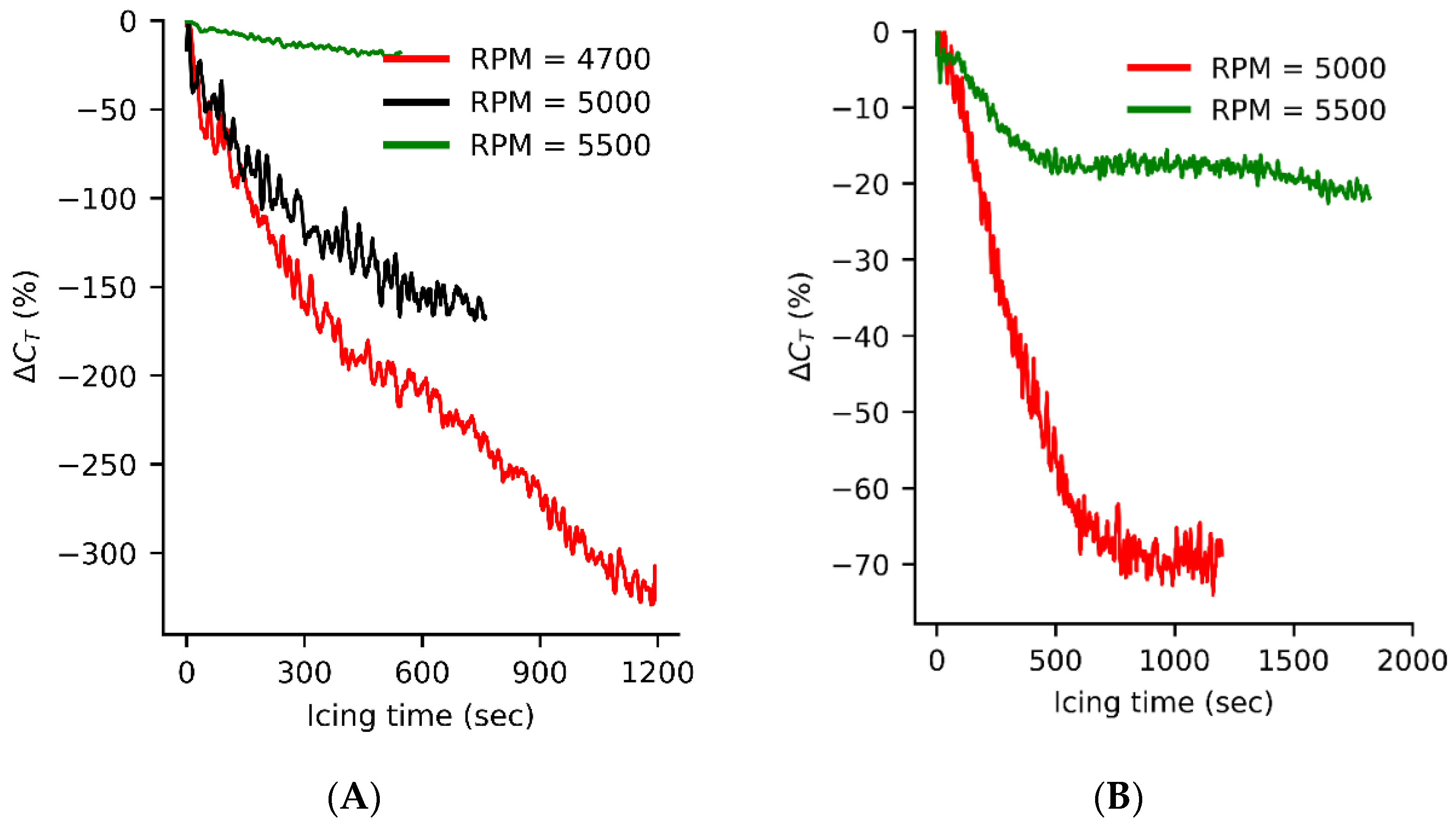
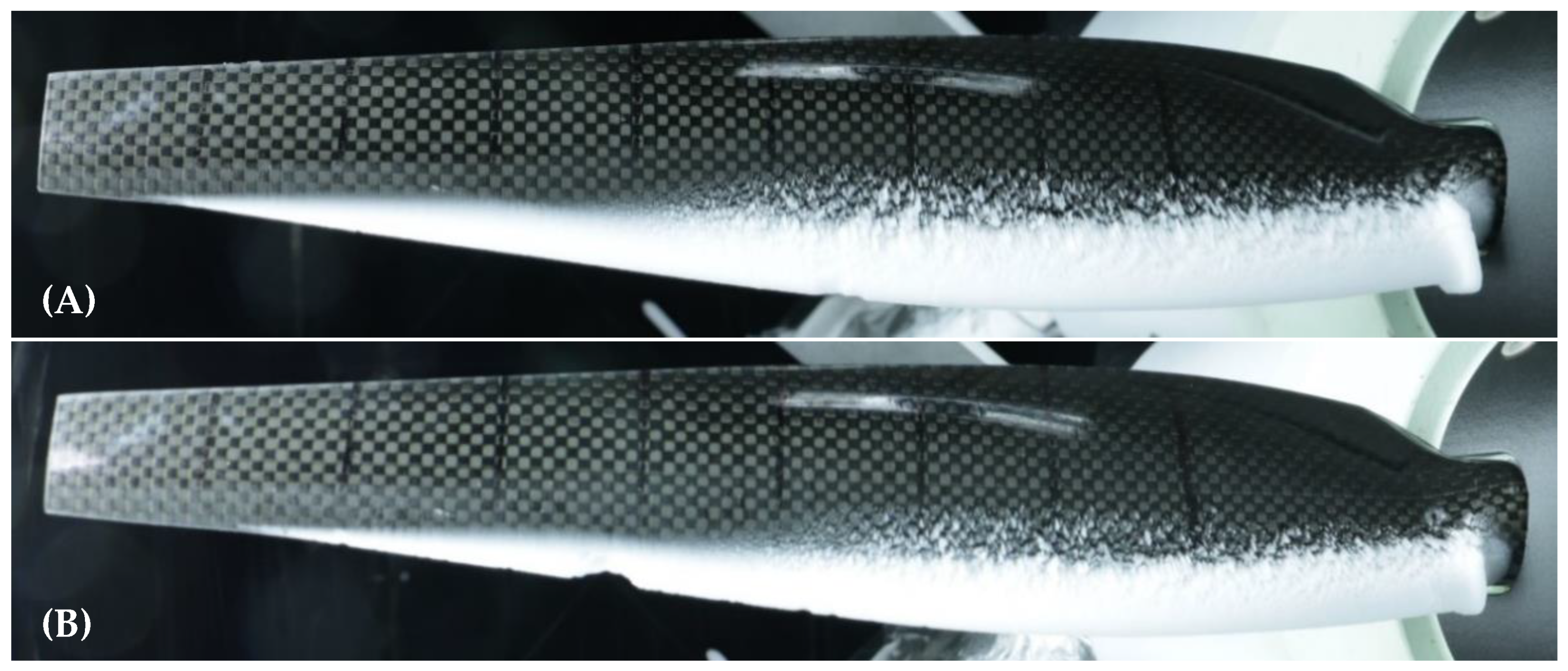

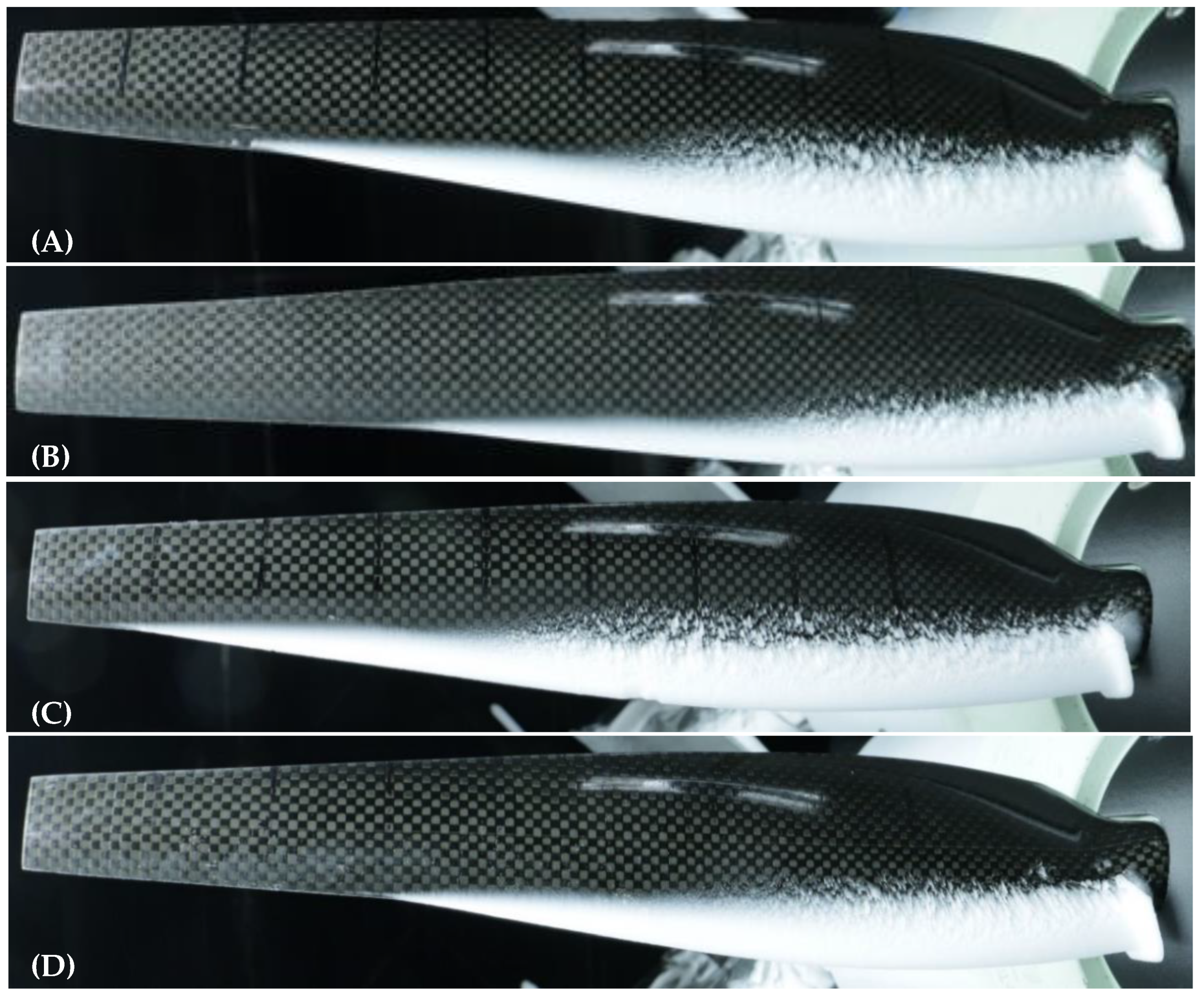
| Blade Pitch | Rotor Speed | Air Velocity | Temperature | MVD | LWC |
|---|---|---|---|---|---|
| (° at Tip) | (103 RPM) | (m/s) | (°C) | (µm) | (g/m3) |
| Effect of LWC | |||||
| 15.7 | 5.5 | 35 | −5 | 20 | 0.2, 0.5 |
| 15.7 | 5.5 | 35 | −12 | 20 | 0.2, 0.5 |
| 15.7 | 5.5 | 35 | −20 | 20 | 0.2, 0.5 |
| Effect of MVD | |||||
| 15.7 | 5.5 | 35 | −12 | 20, 40, 60 | 0.5 |
| 15.7 | 5.5 | 35 | −20 | 20, 60 | 0.5 |
| Effect of RPM | |||||
| 15.7 | 4.7, 5.0, 5.5 | 35 | −12 | 20 | 0.5 |
| 15.7 | 5.0, 5.5 | 35 | −20 | 20 | 0.2 |
| Effect of blade pitch | |||||
| 15.7, 17.7 | 5.0 | 35 | −12 | 20 | 0.2 |
| 15.7, 17.7 | 5.0 | 35 | −12 | 20 | 0.5 |
Disclaimer/Publisher’s Note: The statements, opinions and data contained in all publications are solely those of the individual author(s) and contributor(s) and not of MDPI and/or the editor(s). MDPI and/or the editor(s) disclaim responsibility for any injury to people or property resulting from any ideas, methods, instructions or products referred to in the content. |
© 2024 by the authors. Licensee MDPI, Basel, Switzerland. This article is an open access article distributed under the terms and conditions of the Creative Commons Attribution (CC BY) license (https://creativecommons.org/licenses/by/4.0/).
Share and Cite
Harvey, D.; Villeneuve, E.; Béland, M.; Lapalme, M. Wind Tunnel Investigation of the Icing of a Drone Rotor in Forward Flight. Drones 2024, 8, 380. https://doi.org/10.3390/drones8080380
Harvey D, Villeneuve E, Béland M, Lapalme M. Wind Tunnel Investigation of the Icing of a Drone Rotor in Forward Flight. Drones. 2024; 8(8):380. https://doi.org/10.3390/drones8080380
Chicago/Turabian StyleHarvey, Derek, Eric Villeneuve, Mathieu Béland, and Maxime Lapalme. 2024. "Wind Tunnel Investigation of the Icing of a Drone Rotor in Forward Flight" Drones 8, no. 8: 380. https://doi.org/10.3390/drones8080380
APA StyleHarvey, D., Villeneuve, E., Béland, M., & Lapalme, M. (2024). Wind Tunnel Investigation of the Icing of a Drone Rotor in Forward Flight. Drones, 8(8), 380. https://doi.org/10.3390/drones8080380






